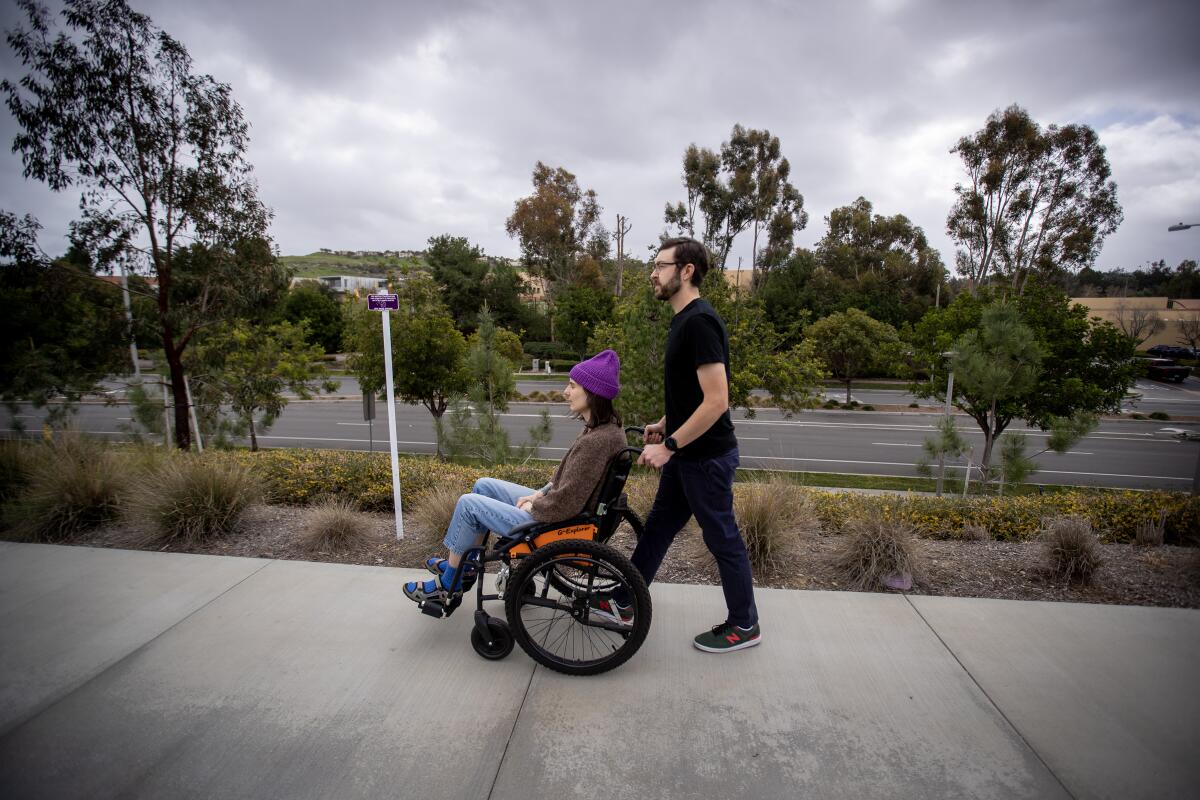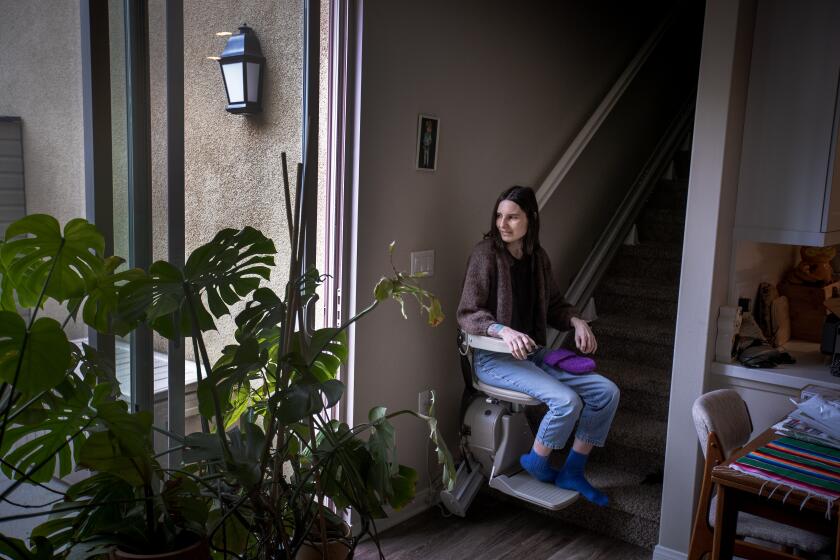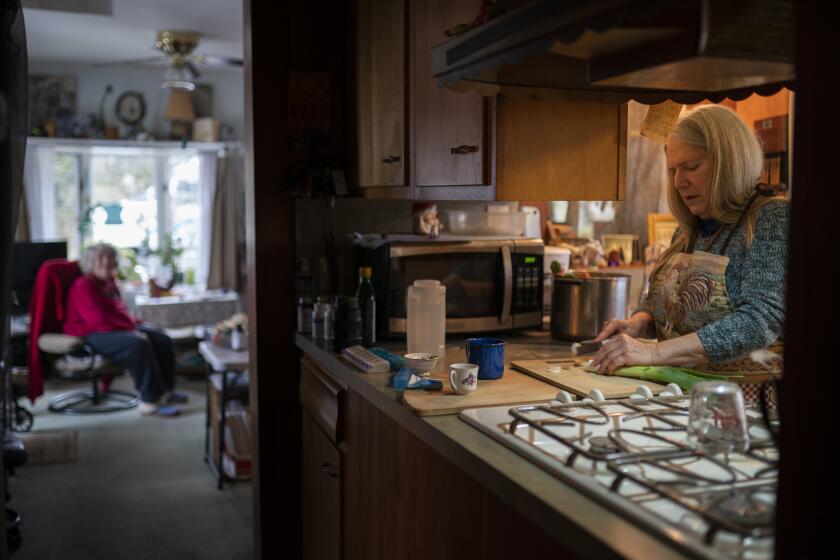Long COVID risk has decreased but remains significant, study finds

- Share via
The risk of developing long COVID — enduring, sometimes punishing symptoms that linger well after a coronavirus infection — has decreased since the start of the pandemic, a new study found, with the drop particularly evident among those who are vaccinated.
But the dip does not mean the risk of developing long COVID has vanished. And given the rise in new infections, particularly during periods like now, when data indicate transmission is elevated, even a lower rate of prevalence means many Americans risk developing symptoms that can last months or years after their initial infection clears.
“We have people in the clinic here with long COVID, and they’re significantly affected, and some of them are profoundly disabled,” said Dr. Ziyad Al-Aly, chief of research and development at the Veterans Affairs St. Louis Health Care System in Missouri.
The study, published Wednesday in the New England Journal of Medicine, found that 10.4% of people who were infected early in the pandemic suffered from long COVID symptoms a year after their acute infection.
But during the Omicron era, which began in mid-December 2021 when that variant became the dominant version of the coronavirus circulating worldwide, 3.5% of vaccinated people suffered from long COVID a year after their infection, as did 7.8% of unvaccinated people.
“It’s good news,” said Al-Aly, a coauthor of the study. “Long COVID is on the descent. It’s declining and has gone down over the course of the pandemic.”
One in 10 people infected with the coronavirus during the Omicron era suffered from long COVID, indicating the syndrome remains a notable threat.
But it’s still a concern that long COVID rates remain as high as they are, Al-Aly said, especially as COVID “is still affecting millions of people.”
“Three-point-five-percent is not zero,” Al-Aly said. “That’s still three to four individuals out of 100 of a disease that could be, in some instances, devastating.”
The study was based on health records held by the U.S. Department of Veterans Affairs, which had data on more than 441,000 veterans who were infected with the coronavirus between March 1, 2020, and Jan. 31, 2022, and monitored for a year after their infection to track whether they experienced long COVID. The other coauthors are Yan Xie and Taeyoung Choi, who are also affiliated with the VA St. Louis Health Care System.
Whenever someone is infected with the coronavirus, there is a chance they will develop long COVID — a catchall term used to describe a wide array of serious symptoms that can result in chronic disability, according to the U.S. Centers for Disease Control and Prevention. Some individuals have suffered from long COVID continuously since they were infected in the pandemic’s earlier days, while others have seen their symptoms resolve within months.
Most L.A. County residents who had long COVID reported symptoms severe enough to limit daily activities weeks after they were infected, a survey found.
Long COVID symptoms include fatigue that interferes with daily life, brain fog and post-exertional malaise, in which symptoms worsen with physical or mental effort. Long COVID can also cause a fast-beating or pounding heart, dizziness when you stand up, depression and anxiety.
Millions of American adults and children have suffered or are still suffering from long COVID.
There are a few potential reasons why long COVID is rarer than it once was.
First, the coronavirus — officially known as SARS-CoV-2 — has changed significantly since it was first identified in December 2019.
“We still call it COVID, but in truth, COVID has really shifted shapes on us, like, multiple times,” Al-Aly said.
That would explain why “the risk has actually declined even among unvaccinated individuals,” Al-Aly said. “So even without being touched by vaccines, just the virus itself has mellowed over time.”
People with symptoms do not need to have tested positive for the coronavirus to be considered for a diagnosis of long COVID, a new report says.
But as the study found, getting vaccinated did further reduce the risk of developing long COVID.
“Vaccines do two things: They first reduce the severity of infection,” Al-Aly said.
Second, “they actually help your immune system get rid of the virus faster,” Al-Aly said. “They enhance the ability of the immune system to clear the virus ... and so there is less virus to wreak havoc” on organs and bodily systems.
One leading theory of the root cause of long COVID is that the coronavirus persists in the body long after an acute infection is over, Al-Aly said. So, if getting a vaccine helps the immune system get rid of the virus faster, that could lessen the chance of developing the syndrome.
“We know vaccine immunity wanes with time,” Al-Aly said. “Definitely keep up to date on your vaccination.”
Three years and $62,000 in medical expenses later, a musician and her caregiving partner struggle to navigate the financial, mental and physical challenges of long COVID.
The severity of long COVID varies from person to person. Some might experience mild cognitive dysfunction or fatigue, but can still accomplish daily tasks like taking their children to school or walking the dog. Others can suffer such “debilitating fatigue that they’re really, really, really profoundly disabled by it — they cannot get out of bed ... they cannot literally perform their activities of daily living,” Al-Aly said.
Long COVID can emerge, persist, resolve and reemerge over a period of weeks or months, according to the CDC.
There are other data suggesting that long COVID’s incidence has declined since earlier in the pandemic. Based on survey data, the prevalence of long COVID among U.S. adults was 7.5% in early June 2022, but had decreased to roughly 6% in early January 2023, according to a report published last summer by the CDC. Since then, the “prevalence remained unchanged” to mid-June 2023, shortly before that report was published.
About 1 in 4 adults who reported having long COVID when surveyed said they had significant limitations on their typical activities — highlighting “the importance of COVID prevention, including staying up to date with recommended COVID-19 vaccination,” the report said.
People who have had COVID-19 have a significantly higher risk of suffering chronic fatigue than those who haven’t had the disease, a new CDC study shows.
COVID and long COVID remain a more significant public health threat than the flu. People sometimes get long-term complications after battling the flu, Al-Aly said, “but there are definitely a whole lot more COVID cases than the flu. So you’re much more likely, probabilistically, to get COVID than the flu.”
Even at this point, more people are dying from and being hospitalized with COVID than the flu, Al-Aly said. The CDC estimates that there have been at least 25,000 flu deaths nationally since the start of October, compared with at least 46,000 COVID-19 deaths reported over the same period. Updated death estimates for the past flu season will be available this autumn.
Besides getting vaccinated, other ways to help avoid long COVID include testing when you’re sick to see if you have COVID. A confirmed diagnosis can help higher-risk people get a prescription for Paxlovid, antiviral pills that can help lessen the severity of infections and potentially reducing the risk of long COVID, Al-Aly said.
It’s too early to know if FLiRT will be a major change in the COVID picture; so far impacts have been small. But officials are urging Californians to be prepared.
Other steps include wearing a mask in higher-risk situations. Al-Aly said he wears an N95 mask on planes, and masks strategically in higher-risk settings. He’s also more on guard about masking when there’s an uptick in COVID, as there is now nationally. And dining at restaurants outdoors remains less risky than dining indoors.
More to Read
Sign up for Essential California
The most important California stories and recommendations in your inbox every morning.
You may occasionally receive promotional content from the Los Angeles Times.

















